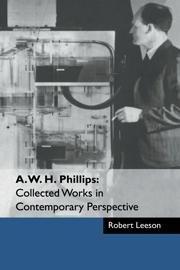Book contents
- Frontmatter
- Contents
- List of contributors
- Foreword by Arthur Brown
- Preface by Robert Leeson
- Part I Bill Phillips: Some Memories and Reflections
- Part II The Phillips Machine
- Part III Dynamic Stabilisation
- 15 The optimal control articles
- 16 Stabilisation policy in a closed economy
- 17 Stabilisation policy and the time-forms of lagged responses
- 18 Arnold Tustin's The Mechanism of Economic Systems: a review
- 19 Michel Kalecki's Theory of Economic Dynamics: An Essay on Cyclical and Long-Run Changes in the Capitalist Economy: a review
- 20 The growth articles
- 21 A simple model of employment, money and prices in a growing economy
- 22 Employment, inflation and growth
- 23 Economic policy and development
- 24 The famous Phillips Curve article
- 25 The relation between unemployment and the rate of change of money wage rates in the United Kingdom, 1861-1957
- 26 Discussion of Dicks-Mireaux and Dow's The Determinants of Wage Inflation: United Kingdom, 1946-1956
- 27 The Melbourne paper
- 28 Wage changes and unemployment in Australia, 1947-1958
- 29 Phillips and stabilisation policy as a threat to stability
- 30 The Phillips Curve in macroeconomics and econometrics
- 31 Bill Phillips' contribution to dynamic stabilisation policy
- 32 A Left Keynesian view of the Phillips Curve trade-off
- 33 Interactions with a fellow research engineer-economist
- 34 Does modern econometrics replicate the Phillips Curve?
- 35 The famous Phillips Curve article: a note on its publication
- Part IV Econometrics
- References
- Index of names
- Index of subjects
15 - The optimal control articles
Published online by Cambridge University Press: 04 May 2010
- Frontmatter
- Contents
- List of contributors
- Foreword by Arthur Brown
- Preface by Robert Leeson
- Part I Bill Phillips: Some Memories and Reflections
- Part II The Phillips Machine
- Part III Dynamic Stabilisation
- 15 The optimal control articles
- 16 Stabilisation policy in a closed economy
- 17 Stabilisation policy and the time-forms of lagged responses
- 18 Arnold Tustin's The Mechanism of Economic Systems: a review
- 19 Michel Kalecki's Theory of Economic Dynamics: An Essay on Cyclical and Long-Run Changes in the Capitalist Economy: a review
- 20 The growth articles
- 21 A simple model of employment, money and prices in a growing economy
- 22 Employment, inflation and growth
- 23 Economic policy and development
- 24 The famous Phillips Curve article
- 25 The relation between unemployment and the rate of change of money wage rates in the United Kingdom, 1861-1957
- 26 Discussion of Dicks-Mireaux and Dow's The Determinants of Wage Inflation: United Kingdom, 1946-1956
- 27 The Melbourne paper
- 28 Wage changes and unemployment in Australia, 1947-1958
- 29 Phillips and stabilisation policy as a threat to stability
- 30 The Phillips Curve in macroeconomics and econometrics
- 31 Bill Phillips' contribution to dynamic stabilisation policy
- 32 A Left Keynesian view of the Phillips Curve trade-off
- 33 Interactions with a fellow research engineer-economist
- 34 Does modern econometrics replicate the Phillips Curve?
- 35 The famous Phillips Curve article: a note on its publication
- Part IV Econometrics
- References
- Index of names
- Index of subjects
Summary
Chapters 16, 17, 18 and 19 summarise Bill Phillips' early thoughts on the problems of regulating an economy. There can be little doubt that the ideas were sourced from his background and interest in electrical engineering and were essentially a transcription of the methods of ‘classical ’ control to the economic system. Concepts such as the multiplier, accelerator, real balance (Pigou) effects, etc. were used to describe the system in terms whereby the engineering concepts might be applied. These essays are still cited forty years after their publication. It is worth exploring why this is so, as few essays written in that era would have such longevity. To do so, it is useful to spell out what I perceive of as the innovations in the essays.
First, policy should not be thought of in a static but dynamic mode. This idea may seem trite but the accepted analysis of the time was largely one of comparative statics. ‘Policy’ consisted of shifting the aggregate demand curve up and down the ‘45° line’. The theoretical foundation of policy laid out in Tinbergen's (1952) classic work was also static. Where the past was recognised it was simply taken as predetermined. The objective of policy was either to manipulate instruments to hit a specified target value or to get as close as possible to this value in the event that some trade-off between targets was needed due to a lack of instruments.
- Type
- Chapter
- Information
- A. W. H. Phillips: Collected Works in Contemporary Perspective , pp. 129 - 133Publisher: Cambridge University PressPrint publication year: 2000
- 1
- Cited by



